
Nudibranchs are a group of soft-bodied, marine gastropod molluscs which shed their shells after their larval stage. They are noted for their often extraordinary colours and striking forms, and they have been given colourful nicknames to match, such as "clown," "marigold," "splendid," "dancer," "dragon," or "sea rabbit." Currently, about 3,000 valid species of nudibranchs are known.
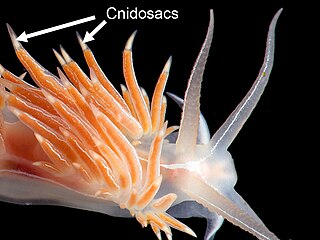
Cerata, singular ceras, are anatomical structures found externally in nudibranch sea slugs, especially in aeolid nudibranchs, marine opisthobranch gastropod mollusks in the clade Aeolidida. The word ceras comes from the Greek word "κέρας", meaning "horn", a reference to the shape of these structures.

The white-edged nudibranch, Fjordia capensis, is a species of sea slug, specifically an aeolid nudibranch, a very colourful sea slug. It is a marine gastropod mollusc in the family Flabellinidae.

Pteraeolidia ianthina is a sea slug, an aeolid nudibranch in the family Facelinidae. It is known as a blue dragon, a name it shares with Glaucus atlanticus and Glaucus marginatus.

Berghia is a genus of sea slugs, aeolid nudibranchs. They are shell-less marine gastropod molluscs in the family Aeolidiidae. They are covered in cerata which give them their unique tentacle look and color. Berghia are commonly found in shallow waters and their diet consists of strictly Aiptasia Anemone. This genus is now commonly used commercially to fight off Anemone populations in fish tanks.
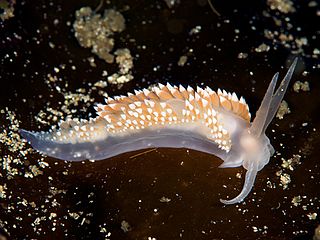
Coryphella verrucosa, is a species of sea slug, an aeolid nudibranch, a marine gastropod mollusc in the family Flabellinidae. It is found on either side of the northern part of the Atlantic Ocean.

A cnidosac is an anatomical feature that is found in the group of sea slugs known as aeolid nudibranchs, a clade of marine opisthobranch gastropod molluscs. A cnidosac contains cnidocytes, stinging cells that are also known as cnidoblasts or nematocysts. These stinging cells are not made by the nudibranch, but by the species that it feeds upon. However, once the nudibranch is armed with these stinging cells, they are used in its own defense.
Anteaeolidiella saldanhensis, is a species of sea slug, an aeolid nudibranch. It is a shell-less marine gastropod mollusc in the family Aeolidiidae.
Anteaeolidiella fijensis, is a species of sea slug, an aeolid nudibranch. It is a marine gastropod mollusc in the family Aeolidiidae.
Anteaeolidiella ireneae is a species of sea slugs, an aeolid nudibranch. It is a marine gastropod mollusc in the family Aeolidiidae.
Anteaeolidiella poshitra, is a species of sea slugs, an aeolid nudibranch. It is a marine gastropod mollusc in the family Aeolidiidae.
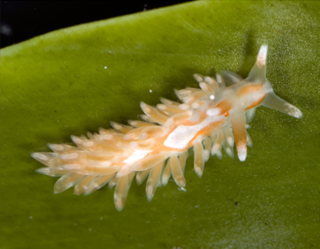
Anteaeolidiella lurana, is a species of sea slug, an aeolid nudibranch. It is a marine gastropod mollusc in the family Aeolidiidae.

Anteaeolidiella oliviae, is a species of sea slug, an aeolid nudibranch. It is a marine gastropod mollusc in the family Aeolidiidae.

Berghia stephanieae is a species of sea slug, an aeolid nudibranch. It is a marine gastropod mollusc in the family Aeolidiidae. It was previously known as Aeolidiella stephanieae.

Spurilla neapolitana, the Neapolitan spurilla, is a species of sea slug, an aeolid nudibranch, a marine gastropod mollusk in the family Aeolidiidae. It is native to the western Atlantic Ocean, the Caribbean Sea and the Mediterranean Sea. This species was first described as Eolis neapolitana by the Italian naturalist Stefano delle Chiaje in 1841. However, although some authorities quote the year as 1823, the species does not appear in the first volume of delle Chiaje's memoirs, which was published that year. The species was later reassigned to the genus Spurilla.
Cerberilla mosslandica is a species of sea slug, an aeolid nudibranch, a marine heterobranch mollusc in the family Aeolidiidae.

Aeolidiella alderi is a species of sea slug, an aeolid nudibranch in the family Aeolidiidae. It is native to northwestern Europe where it occurs in the intertidal zone. It is a predator and feeds on sea anemones.
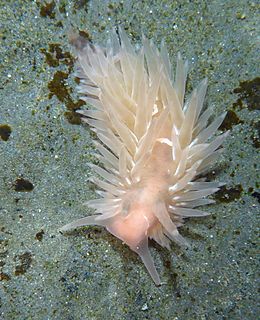
Aeolidia loui is a species of sea slugs, an aeolid nudibranch, a marine gastropod mollusc in the family Aeolidiidae. It has been regarded as the same species as the NE Atlantic Aeolidia papillosa but is now known to be a distinct species. Common names include shaggy mouse nudibranch, and shag-rug nudibranch.

Aeolidia filomenae is a species of sea slugs, an aeolid nudibranch, a marine gastropod mollusc in the family Aeolidiidae. Previously confused with Aeolidia papillosa, this species occurs on coasts of the NE Atlantic Ocean from Scotland south to Portugal.
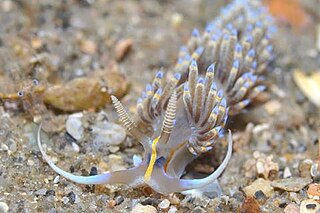
Dondice occidentalis is a species of sea slug, an aeolid nudibranch, a marine gastropod mollusk in the family Facelinidae.














